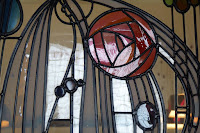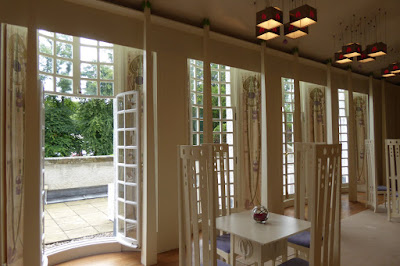I enjoyed the experience. When you sign up, you get to select, online, at which building - out of those participating that have requested help - you want to be posted. I chose a fairly low-key, but seemingly interesting site: a 'House for a Painter', a former photography studio (and before that, Victorian warehouse) in Wandsworth, whose artist owner, Will Monk, wanted to convert into a combined living quarters for his family and studio unit. Architect Dingle Price has pulled this off by, in effect, inserting a modest-yet-fully appointed 2-storey house into one half of the floorplan, leaving a double height studio to occupy the remaining space.
 |
| (http://www.themodernhouse.com/sales-list/house-for-a-painter/) |
Anyway... as for the volunteering experience, my main function as a steward, it was explained, was to cast a watchful eye to make sure no-one was opening cupboards, playing with taps or generally being overly-familiar with the home and the owners' belongings. In fact, this task was relatively straightforward, since Dingle, the architect, gave all entering visitors a brief spiel explaining the history of the project and setting out the ground rules about not touching things or taking photos. I only had to intervene twice, I think: once to prevent someone nosying in a wardrobe and the other time to stop a toddler from toppling a crate on which a lamp was resting.
Other than this, it was just a case of fielding questions from the visitors as best I could (as a volunteer you are issued with a "Can I help?" sticker). It was interesting to hear what sort of questions people ask. Mainly basic stuff, which you find you can, surprisingly, answer (not least because it was already covered in the introduction that the architect gives and which you overhear being rehearsed several times thoughout the day). Eg, What is this place? Who lives here? What was the building originally? Easy-peasy.
Sometimes people ask about the furnishings and fittings, in which case it's more hit and miss. I should have perhaps thought to ask beforehand about the kitchen worksurface, since there were inevitably a couple of questions about that. I was happy, though, to be able to identify what the reproduction Gerrit Rietveld Red and Blue Chair in the living room was supposed to be when I was asked about this (all that De Stijl spotting on my trips to the Netherlands has finally paid off). Other questions, though (including a request to sit in the aforementioned, rather delicate-looking, chair) I had to refer to the owners, who were onsite as well to oversee proceedings.
There were a couple of other stewards on the afternoon 'shift' with me. It was interesting to talk to with each other and discuss our respective backgrounds and motivations for volunteering. One lady was a trained architect, and I think she mentioned, architecture teacher. I mentioned my writing about the subject and my background in construction law work. The other person wasn't herself in this line of work, but her daughter was an architect and that had inspired her to take part in the event.
Indeed, not just the volunteers but many of the people who attend Open House buildings as visitors are connected in some way to the industry: at all of the architect-led tours I've been on over the years as part of the weekend, you hear questions from the attendees about aggregate mixes, roof drainage and so on which could only come from QSs, engineers or other people fairly versed in these thing.
But some attendees are simply locals curious to get under the skin of the area where they live. Such as, apparently, David Harewood, the famous Homeland actor, who dropped by late in the afternoon. One of my fellow stewards had a long chat with him: it turned out they knew each other as their respective children go to the same school, in a neighbouring borough. It's a small world.
















